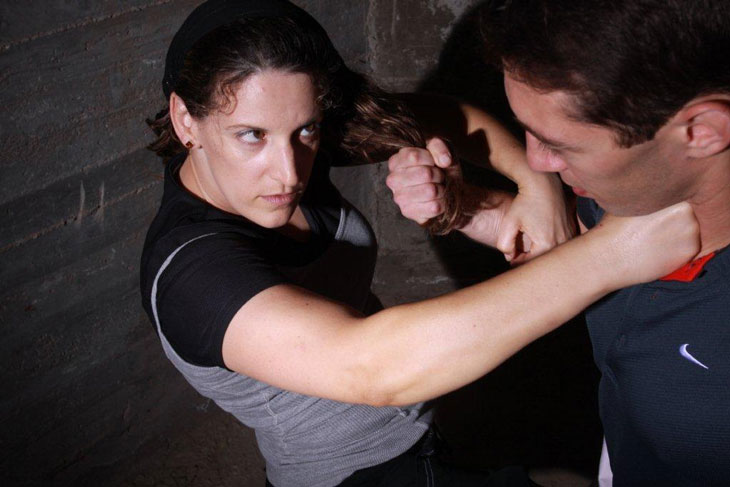Krav Maga vs. Muay Thai
When looking at Krav Maga vs Muay Thai, there are both similarities and key differences that are immediately apparent. Muay Thai –– also referred to as Thai boxing –– is a popular martial art that relies primarily on striking opponents both at distance and in close quarters. Krav Maga, on the other hand, is a self defense system built on brutal efficiency which borrows techniques from martial arts. Both of these styles have soared in popularity in recent years, and the right choice for your training ultimately depends on your personal goals.
Let’s take a closer look at the differences between Krav Maga and Muay Thai.
A Brief History Of Krav Maga
For those interested in self defense, the development of Krav Maga over time has remained true to its initial purpose. Krav Maga was born out of necessity on the streets of Bratislava, Slovakia, when Imi Lichtenfeld combined his experience in street fighting, boxing, and wrestling into a system he used to protect Jewish neighborhoods from anti-Semitic gangs in the lead-up to World War II. As he trained like-minded defenders, a distinct combat system began to emerge.
After the war, Imi continued Krav Maga’s development, teaching his system to the Israel Defense Forces. Under his tutelage, the IDF became known for its unarmed combat prowess in action against terrorists, during hostage rescue attempts, and in military operations. This success garnered interest from law enforcement departments and military branches around the world.
Today, you’ll find Krav Maga training on United States military installations, and within police training programs. However, Krav Maga isn’t only useful to soldiers and police officers; the same techniques that protect our men and women in uniform can help civilians protect themselves in tactical situations on the streets.
A Brief History Of Muay Thai
One similarity when comparing Krav Maga vs Muay Thai is that Muay Thai also grew from local and regional fighting styles in Thailand as a means for self defense. By the mid-1500s, these styles were being incorporated into military training exercises. By the early 1900s, tournaments pitting combatants against each other had become a popular spectator sport and with the application of British boxing rules, modern Muay Thai began to emerge. After the codification of rules under King Rama VII, the sport surged in popularity.
As professional Muay Thai practitioners began to find success competing globally in kickboxing competitions, foreign audiences were introduced to the Muay Thai style. Federations to promote Muay Thai as a sport and organize competitions under unified rules became increasingly commonplace. With the rising popularity of mixed martial arts throughout the 1990s and 2000s, Muay Thai striking techniques found a new home in televised cage fighting.
Krav Maga vs Mutay Thai: A Head-to-Head Comparison

Techniques
Muay Thai is sometimes called the Art of Eight Limbs due to its focus on strikes with the hands, elbows, knees, and shins, with the addition of a neck clinch to guide the opponent’s head into strikes. During strikes, the entire body rotates to deliver the most power possible. Opponents exchange blows, giving and receiving with an emphasis on blocking rather than avoidance until one is rendered incapacitated by cumulative damage.
Krav Maga is designed to use your body’s instinctual movements for fast, brutal attacks. Krav Maga attacks (vs Muay Thai’s war of attrition style) are designed to deliver maximum power to the most vulnerable target areas of your attacker. While blocking is necessary, the idea is not to get hurt, so not being hit is encouraged. Krav Maga attacks include kicks, punches, knees, shins, locks, and throws.
Sport vs Self-Defense
While they share similar roots, modern Muay Thai vs Krav Maga is very much a comparison of a combat sport and a self-defense system. As a sport, Muay Thai rules are designed to promote fairness and protect the fighters from serious injury. Some strikes, like those to the knees or groin, are not allowed.
Krav Maga’s first and most important rule is to survive. Strikes should be directed toward your opponent’s vulnerable areas, including joints and the groin. There are no points or referees, so you do what you have to in order to survive.
Adaptability
Muay Thai athletes train to fight other Muay Thai athletes in competition. Krav Maga practitioners may find themselves in situations where they are facing a person with a knife, a gun, or another weapon –– and willing to use it. Unlike Muay Thai, Krav Maga training focuses not on countering someone with your own skill set but countering whatever your attacker may bring to the table. This adaptability makes Krav Maga a uniquely effective self defense tool for a wide range of situations.
Real-World Self-Defense
In a fight, it is true that much of the outcome is due to the way a martial artist uses their skills, and not the refined skills and techniques they’ve learned in the carefully controlled environment of a gym or dojo. If you train for points or within the rules of a competition, then that’s likely what you’ll do on the street. Krav Maga utilizes real-world scenarios and teaches you how to react to those situations to ensure your survival.
Train To Survive
Muay Thai is an honorable martial art and may be an excellent choice for those seeking to participate in athletic competitions. If you want the conditioning and skills to protect yourself and from real threats, you need a powerful and proven self defense system that men and women around the world put into use every day. The choice between Krav Maga vs Muay Thai is that simple. Stop by a Krav Maga Worldwide location or affiliate today to see the difference for yourself.
